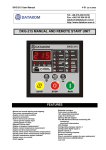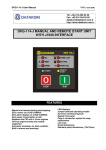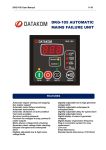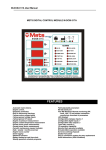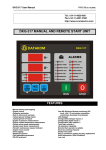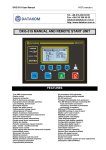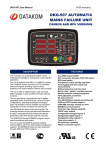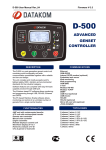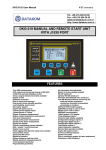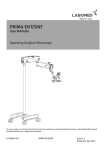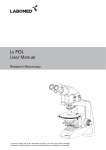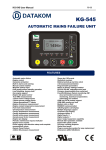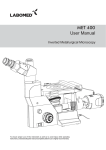Download dkg-207 automatic mains failure and remote start unit
Transcript
DKG-207 User Manual V-01.03 (14.02.2006) Tel: +90-216-466 84 60 Fax: +90-216 364 65 65 [email protected] DKG-207 AUTOMATIC MAINS FAILURE AND REMOTE START UNIT FEATURES Automatic mains failure, Engine control, Generator protection, Built in alarms and warnings, 3 phase mains voltage inputs 1 phase genset voltage input 1 phase genset CT input Engine oil pressure measurement Engine coolant temperature measurement Genset active power measurement Genset power factor measurement Periodic maintenance request indicator Daily / weekly / monthly exerciser Engine hours counter Statistical counters Field adjustable parameters Logic level serial port Optional RS-232 adapter Free MS-Windows Remote monitoring SW: -local, LAN, IP and modem connection -monitoring, download of parameters LED displays Configurable analogue inputs: 2 Configurable digital inputs: 5 Configurable relay outputs: 2 Total relay outputs: 6 Remote Start operation available Survives cranking dropouts Sealed front panel Plug-in connection system for easy replacement Small dimensions (120x90x39mm) Low cost DKG-207 User Manual V-01.03 (14.02.2006) TABLE OF CONTENTS Section 1. INSTALLATION 1.1. Introduction to the Control Panel 1.2. Mounting the Unit 1.3. Wiring the Unit 2. INPUTS AND OUTPUTS 3. DISPLAYS 3.1. Led Displays 3.2. Digital Display 4. ALARMS AND WARNINGS 5. MODES OF OPERATION 6. OTHER FEATURES 6.1. Remote start operation 6.2. Sender type selection 6.3. Engine heating operation 6.4. Service Request Display 6.5. Engine Hour Meter 6.6. Modem connection 6.7. Remote Monitoring and Programming 6.8 Intermittent operation in AUTO mode 6.9 Exerciser 7. STATISTICAL COUNTERS 8. MAINTENANCE 9. PROGRAMMING 10. TROUBLESHOOTING 11. DECLARATION OF CONFORMITY 12. TECHNICAL SPECIFICATIONS 13. CONNECTION DIAGRAM -2- DKG-207 User Manual V-01.03 (14.02.2006) 1. INSTALLATION 1.1 Introduction to the Control Panel The unit is a control and protection panel used in gensets. It shows the measured values on its displays. The unit is designed to provide user friendliness for both the installer and the user. Programming is usually unnecessary, as the factory settings have been carefully selected to fit most applications. However programmable parameters allow the complete control over the generating set. Programmed parameters are stored in a Non Volatile Memory and thus all information is retained even in the event of complete loss of power. The measured parameters are: Mains voltage phase R to neutral Mains voltage phase S to neutral Mains voltage phase T to neutral Mains voltage phase R-S Mains voltage phase S-T Mains voltage phase T-R Gen voltage phase U to neutral Gen current phase U Gen KW phase-U Gen cosΦ phase-U Battery voltage, Coolant temperature Oil pressure Gen frequency 1.2 Mounting the Unit The unit is designed for panel mounting. The user should not be able to access parts of the unit other than the front panel. Mount the unit on a flat, vertical surface. The unit fits into an opening of 116x86 millimeters. Before mounting, remove the retaining steel spring and connectors from the unit, then pass the unit through the mounting opening. The unit will be maintained in its position by the steel spring. Engine body must be grounded for correct operation of the unit, otherwise incorrect voltage and frequency measurements may occur. The output of the current transformers shall be 5 Amperes. The input current rating of the current transformers may be selected as needed (between 10/5 and 9000/5 amps). Current transformer outputs shall be connected by separate cable pairs from each transformer, to related inputs. Never use common terminals or grounding. The power rating of the transformer should be at least 5 VA. It is recommended to use 1% precision transformers. If analogue senders (e.g. temperature or oil pressure) are connected to the unit, it is not possible to use auxiliary displays, otherwise the unit may be destroyed. If temperature or oil pressure displays are already present on the generator control panel, do not connect the senders to the unit. The unit is factory programmed for VDO type senders. However different types of senders are selectable via programming menu. Please check the programming section. The programmable digital inputs are compatible with both ‘normally open’ and ‘normally closed’ contacts, switching either to BAT- or BAT+. The charge alternator connection terminal provides also the excitation current, thus it is not necessary to use an external charge lamp. -3- DKG-207 User Manual V-01.03 (14.02.2006) 1.3 Wiring the Unit WARNING: THE UNIT IS NOT FUSED. Use external fuses for Mains phases: R-S-T Generator phase: U Battery positive: BAT(+). Install the fuses as nearly as possible to the unit in a place easily accessible for the user. The fuse rating should be 6 Amps. WARNING: ELECTRICITY CAN KILL ALWAYS disconnect the power BEFORE connecting the unit. 1) ALWAYS remove the plug connectors when inserting wires with a screwdriver. 2) ALWAYS refer to the National Wiring Regulations when conducting installation. 3) An appropriate and readily accessible set of disconnection devices (e.g. automatic fuses) MUST be provided as part of the installation. 4) The disconnection device must NOT be fitted in a flexible cord. 5) The building mains supply MUST incorporate appropriate short-circuit backup protection (e.g. a fuse or circuit breaker) of High Breaking Capacity (HBC, at least 1500A). 2 6) Use cables of adequate current carrying capacity (at least 0.75mm ) and temperature range. -4- DKG-207 User Manual V-01.03 (14.02.2006) 2. INPUTS AND OUTPUTS SERIAL DATA: This connector provides logic level serial data input and output for various purposes like remote monitoring and remote programming. In order to connect to a PC, an RS-232 adapter module is needed. Term Function 1 GENERATOR CONTACTOR 2 U 3 4 5 6 7 8 GENERATOR NEUTRAL MAINS NEUTRAL T S R MAINS CONTACTOR 9 OIL PRESSURE SENDER 10 COOLANT TEMP. SENDER 11 BATTERY POSITIVE 12 13 GROUND RELAY-1 (HORN RELAY) 14 15 START RELAY FUEL RELAY 16 CHARGE Technical data Description Relay output, 16A-AC This output provides energy to the generator contactor. If the generator phases do not have acceptable voltage or frequency values, the generator contactor will be de-energized. In order to provide extra security, the normally closed contact of the mains contactor should be serially connected to this output. Generator phase Connect the generator phases to these inputs. input, 0-300V-AC The generator phase voltages upper and lower limits are programmable. Input, 0-300V-AC Neutral terminal for the generator phases. Input, 0-300V-AC Neutral terminal for the mains phases. Mains phase inputs, Connect the mains phases to these inputs. 0-300V-AC The mains voltages upper and lower limits are programmable. Relay output, 16A-AC This output provides energy to the mains contactor. If the mains phases do not have acceptable voltages, the mains contactor will be de-energized. In order to provide extra security, the normally closed contact of the generator contactor should be serially connected to this output. Input, 0-5000 ohms Analogue oil pressure sender connection. Do not connect the sender to other devices. The input has programmable characteristics and connects to any kind of sender. Input, 0-5000 ohms Analogue high temperature sender connection. Do not connect the sender to other devices. The input has programmable characteristics and connects to any kind of sender. +12 or 24VDC The positive terminal of the DC Supply shall be connected to this terminal. The unit operates on both 12V and 24V battery systems. O VDC Power supply negative connection. Output 10A/28VDC This relay has programmable function, selectable from a list. Output 10A/28VDC This relay controls the engine cranking. Output 10A/28VDC This relay is used for fuel solenoid control. It is internally connected to terminal 16 for supplying the charge alternator’s excitation current. Input and output Connect the charge alternator’s D+ terminal to this terminal. This terminal will supply the excitation current and measure the voltage of the charge alternator. -5- DKG-207 User Manual Term Function 17 RELAY-2 (STOP RELAY) 18 19 20 21 22 23 LOW OIL PRESSURE HIGH TEMP RECTIFIER FAIL EMERGENCY STOP SPARE/REMOTE START PROGRAM LOCK 24 CURR_U+ 25 CURR_U- V-01.03 (14.02.2006) Technical data Output 10A/28VDC Description This relay has programmable function, selectable from a list. Digital inputs These inputs have programmable characteristics selected via the program menu. Each input may be driven by a ‘normally closed’ or ‘normally open’ contact, switching either battery+ or battery-. The effect of the switch is also selectable from a list. See PROGRAMMING section for more details. Current transformer Connect the generator current transformer inputs, 5A-AC terminals to these inputs. Do not connect the same current transformer to other instruments otherwise a unit fault will occur. Connect each terminal of the transformer to the unit’s related terminal. Do not use common terminals. Do not use grounding. Correct polarity of connection is vital. If the measured power is negative, then change the polarity of each 3 current transformers. The secondary winding rating shall be 5 Amperes. (For ex. 200/5 Amps). -6- DKG-207 User Manual V-01.03 (14.02.2006) 3. DISPLAY 3.1 Led Displays The unit has 18 LEDs, divided in 4 groups: -Group_1: Operating mode: This group indicates the genset function. -Group_2: Mimic diagram: This group indicates the current status of the mains and genset voltages and contactors. -Group_3: Warnings and alarms: This group indicates the existence of abnormal conditions encountered during operation. -Group_4: Unit: This group indicates the unit of the value displayed in the bottom display. Function GENERATOR Color Yellow MAINS Green TEST Yellow AUTO Green SERVICE REQUEST Red ALARM GROUP Red UNIT GROUP Red Description The LED will flash when the generator phase voltage is within the programmed limits. It turns on when the generator contactor is activated. The LED will flash when all 3 mains phase voltages are within the limits. It turns on when the mains contactor is activated. It turns on when the related operation mode is selected. These LEDs indicate which operation mode is selected. Both leds are off in the OFF mode. Engine periodic maintenance request indicator. It turns on when the preset engine hours or time duration after previous service has elapsed. If a fault condition resulting to the engine shutdown has occurred, the related alarm led turns on steadily. If a warning condition has occurred, the related led flashes. The alarms work on a first occurring basis. The occurrence of a fault will disable other faults of lower or equal priority. This group indicates the unit of the value displayed in the digital display. When the engine is running the unit displays the genset frequency, otherwise it displays the mains phase-R voltage. Different values may be scrolled by pressing the MENU key. -7- DKG-207 User Manual V-01.03 (14.02.2006) 3.2 Digital Display The unit has a seven segment display. It shows: -Measured parameters, -Parameter names, -Service counters, -Program parameters. The navigation between different screens in a group is made with the MENU button. When the MENU key is pressed, the parameter name will be displayed. By pressing the MENU key, below values may be displayed: -(R-S-T) mains phase to neutral voltages -generator phase-U to neutral voltage -generator phase-U current, -generator frequency (Hz) -generator cos -generator active power (KW) -oil pressure (bar) -coolant temperature (ºC) -battery voltage (V-DC), group: Holding the MENU button pressed for 1 second makes the display to switch to the service counters -total engine hours, -engine hours to service, -time to service. -8- DKG-207 User Manual V-01.03 (14.02.2006) 4. ALARMS AND WARNINGS Alarms indicate an abnormal situation in the generating set are divided into 2 priority levels: 1- ALARMS: These are the most important fault conditions and cause: - The related alarm led to turn on steadily, - The genset contactor to be released immediately, - The engine to be stopped immediately, - The Horn, Alarm and Alarm+Warning relay outputs to operate, (if selected via programming menu) 2- WARNINGS: These conditions cause: - The related alarm led to flash, - The Horn and Alarm+Warning relay outputs to operate, (if selected via programming menu) If the ALARM MUTE button is pressed, the Horn relay output will be deactivated; however the existing alarms will persist and disable the operation of the genset. Alarms operate in a first occurring basis: -If an alarm is present, following alarms and warnings will not be accepted, -If a warning is present, following warnings will not be accepted. Alarms may be of LATCHING type following programming. For latching alarms, even if the alarm condition is removed, the alarms will stay on and disable the operation of the genset. The existing alarms may be canceled by pressing one of the operating mode buttons (LOAD TEST / TEST / OFF / AUTO). Most of the alarms have programmable trip levels. See the programming chapter for user adjustable alarm limits. LOW OIL PRESSURE: Set if a signal is detected at the Low Oil Pressure Switch input or the oil pressure value measured from the sender is below the programmed limit. Warning (P_016) and alarm (P-015) limits are separately programmable for the oil pressure sender input. This fault will be monitored with holdoff timer (P_023) delay after the engine is running. Also if the oil pressure switch is open at the beginning of a start attempt, then the engine will not be started and the oil pressure led will flash. When the oil pressure switch closes, normal operation will be resumed. HIGH TEMPERATURE: Set if a signal is detected at the High Temperature Switch input or the coolant temperature value measured from the sender is above the programmed limit. Warning (P_017) and alarm (P_018) limits are separately programmable for the temperature sender input. SPEED: Set if the generator frequency is outside programmed limits (overspeed/Underspeed). This fault will be monitored with holdoff timer (P_023) delay after the engine is running. Different low and high limits for warning and alarm are separately programmable. (P_008/P_009/P_010/P_011) START FAIL: Set if the engine is not running after programmed number of start attempts. (P_035) OVERLOAD: Set if the genset phase current goes over the Overcurrent Limit (P_002) or if the genset power (KW) measured on phase-U goes over the Excess Power (P_003) limit for Overcurrent / Excess Power Timer (P_511). If the currents and power goes below the limits before expiration of the timer then no alarm will be set. VOLTAGE: Set if any of the generator phase voltages goes outside programmed limits (P_006/P_007). This fault will be monitored with holdoff timer (P_023) delay after the engine is running. BATTERY: Set if the battery voltage goes outside programmed limits. During engine cranking this fault is not monitored. Warning level for low battery voltage (P_012) and both warning (P_013) and alarm (P_014) levels for high battery voltage are programmable. CHARGE: Set if a charge alternator failure (or broken belt) occurs. This fault condition may result to a warning or alarm following programming. (P_038) RECTIFIER FAIL: Set if a signal is detected at the rectifier fail input. This input is only monitored when mains voltages are present. EMERGENCY STOP: Set if a signal is detected at the emergency stop input. SPARE: Set if a signal is detected in one of the spare fault input. -9- DKG-207 User Manual V-01.03 (14.02.2006) 5. MODES OF OPERATION The modes of operation are selected by pushing the front panel keys. Changing the operation mode while the genset is running will result to a behavior suitable for the new operating mode. For example, if the AUTO mode is selected when genset is running at TEST mode, then the genset will stop (assuming that the mains voltages are present). OFF: In this mode, the mains contactor will be energized if mains phase voltages are within the programmed limits. The engine will be stopped. AUTO: It is used for genset and mains automatic transfer. If at least one of the mains phase voltages is outside limits (P_004/P_005), the mains contactor will be deactivated. The diesel will be started for programmed times (P_035) after the wait period (P_0026). When the engine runs, the crank relay will be immediately deactivated. The engine will run without load during engine heating period (P_029). After this, if alternator phase voltages and frequency are within limits, then the unit will wait for the generator contactor period (P_032) and the generator contactor will be energized. When all the mains phase voltages are within the limits, the engine will continue to run for the mains waiting period (P_030). At the end of this period the generator contactor is deactivated and the mains contactor will be energized. If a cooling period is given (P_031), the generator will continue to run during cooling period. At the end of the period, the fuel solenoid will be de-energized and the diesel will stop. The unit will be ready for the next mains failure. TEST: It is used to test the generator when the mains are on, or keep the generator running in the emergency backup mode (P_041). The operation of the generator is similar to the AUTO mode, but the mains contactor will not be deactivated if the mains are not off. If the mains are off, mains contactor will be deactivated and the generator contactor will be activated. When the mains are on again, a changeover to the mains will be made, but the engine will be kept running unless another mode is selected. To stop the engine, select AUTO or OFF mode. 6. OTHER FEATURES 6.1 Remote Start Operation The unit offers the possibility of REMOTE START mode of operation. If the program parameter P_042 is set to 1 then the unit will enter to the Remote Start operation. The Remote Start signal should be connected to the SPARE_2 (22) input. The REMOTE START signal may be a NO or NC contact, switching to either battery positive or battery negative. These selections are made using programming menu. In this mode the mains phases are not monitored. If the REMOTE START signal is present then the mains will be supposed to fail, inversely if the REMOTE START signal is absent, then mains voltages will be supposed to be present. The front panels mimic diagram’s mains LEDs will reflect the status of the REMOTE START input. - 10 - DKG-207 User Manual V-01.03 (14.02.2006) 6.2 Sender type Selection The unit has the ability to adapt to any type of oil pressure and temperature senders. The commonly used standard sender characteristics are recorded in memory and selectable from a list. However non standard senders may also be used by entering their characteristics to the table. Oil Pressure Sender Type Selection: The oil pressure sender is selected using parameter P_019. The selectable sender types are: 0: The sender characteristics are defined in table using parameters P_131 to P_142. 1: VDO 0-7 bars (10-180 ohms) 2: VDO 0-10 bars (280-20 ohms) 3: DATCON 0-7 bars (240-33 ohms) 4: DATCON 0-10 bars (240-33 ohms) 5: DATCON 0-7 bars (0-90 ohms) 6: DATCON 0-10 bars (0-90 ohms) 7: DATCON 0-7 bars (75-10 ohms) Temperature Sender Selection: The temperature sender is selected using parameter P_020. The selectable sender types are: 0: The sender characteristics are defined in table using parameters P_143 to P_154. 1: VDO 2: DATCON DAH type 3: DATCON DAL type 6.3 Engine Heating Operation Especially on engine without a body heater, or with a failing one, it may be desired that the genset should not take the load before reaching a suitable temperature. The unit offers 2 different ways of engine heating. 1. Timer controlled heating: This operation mode is selected when the parameter P_037 is set to 0. In this mode, the engine will run during parameter P_029, and then the genset will take the load. 2. Timer and temperature controlled heating: This operation mode is selected when the parameter P_037 is set to 1. In this mode, at first the engine will run during parameter P_029, then it will continue to run until the measured coolant temperature reaches the limit defined in parameter P_022. When the requested temperature is reached, the load will be transferred to the genset. This operation mode may be used as a backup to the engine body heater. If the engine body is warm the heating will be skipped. - 11 - DKG-207 User Manual V-01.03 (14.02.2006) 6.4 Service Request Display This led is designed to help the periodic maintenance of the genset to be made consistently. The periodic maintenance is basically carried out after a given engine hours (for example 200 hours), but even if this amount of engine hours is not fulfilled, it is performed after a given time limit (for example 12 months). The SERVICE REQUEST led has no effect on the genset operation. The unit has both programmable engine hours and maintenance time limit. The engine hours is programmable with 50-hour steps (P_044), the time limit is programmable between with 1 month steps (P_045). If any of the programmed values is zero, this means that the parameter will not be used. For example a maintenance period of 0 months indicates that the unit will request maintenance only based on engine hours, there will be no time limit. If the engine hours is also selected as 0 hours this will mean that the SERVICE REQUEST display will be inoperative. When the engine hours OR the time limit is over, the SERVICE REQUEST led (red) will start to flash. To turn off the led, and reset the service period, press together the ALARM MUTE and LAMP TEST keys for 5 seconds. The upper display will show “SER”. The remaining engine hours and the remaining time limit are kept stored in a non-volatile memory and are not modified by power supply failures. The remaining time and engine hours to service may be checked via the statistics menu selected by pressing the MENU key for 1 second. When the MENU key is pressed the display will show “HtS” (hours to service). When the MENU key is released it will show the first 3 digits of the engine hours to service. When the MENU key is pressed again, the display will show “HtS” (hours to service). When the MENU key is released it will show the last 3 digits of the engine hours to service. When the MENU key is pressed the display will show “ttS” (time to service). When the MENU key is released it will show the first 3 digits of the remaining days to service. When the MENU key is pressed again, the display will show “ttS” (time to service). When the MENU key is released it will show the last 3 digits of the remaining days to service. 6.5 Engine Hour Meter The unit features a non-erasable incremental engine hour meter. The hour meter information is kept in a non-volatile memory and is not modified by power supply failures. The engine hours may be displayed via the statistics menu selected by pressing the MENU key for 1 second. When the MENU key is pressed the display will show “EnH” (engine hours). When the MENU key is released it will show the first 3 digits of the engine hours. When the MENU key is pressed again, the display will show “EnH” (engine hours). When the MENU key is released it will show the last 3 digits of the engine hours. - 12 - DKG-207 User Manual V-01.03 (14.02.2006) 6.6 Modem Connection The unit offers the remote monitoring and programming features over the telephone network via a modem connection. The program used for remote monitoring and programming is the same as the program used for RS-232 connection. If the modem is connected, the program parameter P_043 should be set to 1, otherwise faulty operation may occur. 6.7 Remote Monitoring and Programming feature. Thanks to its standard serial RS-232 port, the unit offers the remote monitoring and programming The remote monitoring and www.datakom.com.tr internet site. programming PC software may be downloaded from The software allows the visualization and recording of all measured parameters. The recorded parameters may then be analyzed graphically and printed. The software also allows the programming of the unit and the storage of the program parameters to PC or the downloading of stored parameters from PC to the unit. 6.8 Intermittent operation in AUTO mode If the load is a battery operated system (like a GSM base station), it may not be necessary to run the genset immediately after a mains failure. The program parameter P_025 defines the genset operation delay after a mains failure in minutes. The delay range is from 0 to 4 hours. Equally it may not be necessary to run the genset indefinitely, because the load charges its batteries when the engine runs. Thus the engine may stop after a sufficient operation period for battery charging. The program parameter P_047 defines the maximum engine operation delay. The range is from 6 minutes to 14 hours. If the delay is set to zero, then the engine will run indefinitely. The parameters P_025 and P_047 used together, provide the intermittent operation needed in GSM base stations. - 13 - DKG-207 User Manual V-01.03 (14.02.2006) 6.9 Exerciser The unit offers automatic exerciser operation. The exercise operation may be done on a daily, weekly or monthly basis. The start day and time of the exercise is programmable as well as its duration. The program parameters related to the exerciser are: P_113: Exercise start day and hour P_114: Exercise duration P_116: Daily / Weekly / Monthly Exercise Please refer to the programming section for a more detailed description of the above parameters. When the start day and hour of exercise has come, the unit will automatically switch to TEST mode and the engine will run. If a mains failure occurs during the exercise, the load will not be transferred to the genset unless the Emergency Backup Operation is allowed by setting the parameter P_041 to 1. Thus it is highly recommended that the Emergency Backup mode enabled with exerciser. At the end of the exercise duration, the unit will switch back to the initial mode of operation. If any of the mode selection keys are pressed during exercise, then the exercise will be ended. - 14 - DKG-207 User Manual V-01.03 (14.02.2006) 7. STATISTICAL COUNTERS The unit provides a set of non resettable incremental counters for statistical purposes. The counters consist on: -total engine cranks, -total genset runs, -total genset on load. These counters are kept in a non-volatile memory and are not affected from power failures. The statistical counters are only displayed on the PC screen using the remote monitoring and programming software. They can not be displayed on the unit. 8. MAINTENANCE DO NOT OPEN THE UNIT There are NO serviceable parts inside the unit. Wipe the unit, if necessary with a soft damp cloth. Do not use chemical agents - 15 - DKG-207 User Manual V-01.03 (14.02.2006) 9. PROGRAMMING The program mode is used to program the timers, operational limits and the configuration of the unit. To enter the program mode, press the MENU button for 5 seconds. The program mode is only allowed if the PROGRAM LOCK input (terminal_23) is left open. If this input is tied to GROUND, the program value modification will be disabled to prevent unauthorized intervention. It is advised to keep the PROGRAM LOCK input tied to GROUND. The program mode will not affect the operation of the unit. Thus programs may be modified anytime, even while the genset is running. In program mode, when the MENU key is pressed the display will show the program parameter number, when the MENU key is released the display will show the program parameter value. The first program number is “000” Each depression of the MENU key will cause the display to switch to the next program parameter. If the MENU key is hold pressed the program numbers will increase by steps of 10. After the last parameter, the display switches back to the first parameter. The displayed parameter value may be increased or decreased using “ ” and “ ” keys. If these keys are hold pressed, the program value will be increased/decreased by steps of 10. Program parameters are kept in a non-volatile memory and are not affected from power failures. To exit the program mode press one of the mode selection keys. If no button is pressed during 1 minute the program mode will be cancelled automatically. Pgm Definition 0 Current Transformer Primary 1 Current Transformer Decimal Point 2 Overcurrent Limit 3 Excess Power Limit 4 Unit Std Val A 500 0 A 500 KW 350 Mains Voltage Low Limit V 170 5 Mains Voltage High Limit V 270 6 Gen. Voltage Low Limit V 180 7 Gen. Voltage High Limit V 270 - 16 - Description This is the rated value of the current transformer. The secondary of the transformer will be 5 Amps. For values over 990A use 10% of the value. These values will be displayed as K-Amperes. (for ex. 1.85KA) Values under 100A may be used by multiplying with 10 in order to enable the current display with 0.1A precision. (for ex: 35.7A) This parameter determines the display range of current and active power: 0: 000-999 1: 0.00-9.99 2: 00.0-99.9 If the current goes above this limit, during the period defined in P_024 an OVERLOAD alarm will be generated. Enter this information with the same format as parameter P_000. If the active power measured on phase-U goes above this limit, during the period defined in P_024, an OVERLOAD alarm will be generated. Enter this information with the same format as parameter P_000. If one of the mains phases goes under this limit, it means that the mains are off and it starts the transfer to the genset in AUTO and TEST modes. If one of the mains phases goes over this limit, it means that the mains are off and it starts the transfer to the genset in AUTO and TEST modes. If the generator phase voltage goes under this limit when feeding the load, this will generate a VOLTAGE alarm and the engine will stop. If the generator phase voltage goes over this limit when feeding the load, this will generate a VOLTAGE alarm and the engine will stop. DKG-207 User Manual Pgm Definition V-01.03 (14.02.2006) Unit Std Val 8 Low Freq. Alarm Hz 30 9 Low Freq. Warning Hz 40 10 High Freq. Warning Hz 54 11 High Freq. Alarm Hz 57 V 9.0 V 31.0 V 33.0 12 13 Low Battery Voltage Warning High Battery Voltage Warning 14 High Battery Voltage Alarm 15 Low Oil Pressure Warning Bar 1.5 16 Low Oil Pressure Alarm Bar 1.0 17 High Temperature Warning ºC 90 18 High Temperature Alarm ºC 98 19 Oil pressure sender type - 1 - 17 - Description If the genset frequency goes under this limit, a SPEED alarm will be generated and the engine will stop. This alarm will be monitored after delay defined in P_023 when the engine runs. If the genset frequency goes under this limit, a SPEED warning will be generated. This warning will be monitored after delay defined in P_023 when the engine runs. If the genset frequency goes over this limit, a SPEED warning will be generated. This warning will be monitored after delay defined in P_023 when the engine runs. If the genset frequency goes over this limit, a SPEED alarm will be generated and the engine will stop. This alarm will be monitored after delay defined in P_023 when the engine runs. If the battery voltage falls below this limit, this will generate a BATTERY warning. If the battery voltage goes over this limit, this will generate a BATTERY warning. If the battery voltage goes over this limit, this will generate a BATTERY alarm and the engine will stop. If the oil pressure measured from the analog input falls below this limit, this will generate an OIL PRESSURE warning. This input will be monitored after delay defined in P_023 when the engine runs. If the oil pressure measured from the analog input falls below this limit, this will generate an OIL PRESSURE alarm. This input will be monitored after delay defined in P_023 when the engine runs. If the coolant temperature measured from the analog input goes over this limit, this will generate a HIGH TEMP. warning. If the coolant temperature measured from the analog input goes over this limit, this will generate a HIGH TEMP. alarm and the engine will stop. This parameter selects the oil pressure sender type. 0: Non standard sender. The sender characteristics are defined in table using parameters P_131 to P_142. 1: VDO 0-7 bars (10-180 ohms) 2: VDO 0-10 bars (280-20 ohms) 3: DATCON 0-7 bars (240-33 ohms) 4: DATCON 0-10 bars (240-33 ohms) 5: DATCON 0-7 bars (0-90 ohms) 6: DATCON 0-10 bars (0-90 ohms) 7: DATCON 0-7 bars (75-10 ohms) DKG-207 User Manual Pgm 20 Definition Temperature sender type V-01.03 (14.02.2006) Unit - Std Val 1 21 Hysteresis Voltage V 8 22 Engine Heating Temperature ºC 50 23 Holdoff timer sec 8 24 Overcurrent / Excess Power /Frequency Timer sec 3 25 Wait before Fuel min 0 26 Preheat timer sec 1 27 Start Timer sec 6 28 Wait between Starts sec 10 29 Engine Heating Timer sec 3 30 Mains Waiting Timer min 0.5 31 Cooling Timer min 1.0 32 Generator Contactor Timer sec 1 33 Mains Contactor Timer sec 1 34 Stop Timer sec 10 35 Start Attempts - 3 - 18 - Description This parameter selects the temperature sender type: 0: The sender characteristics are defined in table using parameters P_143 to P_154. 1: VDO 2: DATCON DAH type 3: DATCON DAL type This parameter provides the mains and genset voltage limits with a hysteresis feature in order to prevent faulty decisions. For example, when the mains are present, the mains voltage low limit will be used as the programmed low limit P_004. When the mains fail, the low limit will be used as P_004+P_021. It is advised to set this value to 8 volts. If it is requested that the engine runs without load until reaching a certain temperature, this parameter defines the temperature. This parameter defines delay after the engine runs and before the fault monitoring is enabled. This is the period between the current or active power goes over the limits (P_002/P_003) and OVERLOAD alarms occurs. This is also the period between the frequency goes out of the limits (P_008/P_011) and SPEED FAULT alarm occurs. This is the time between the mains fails and the fuel solenoid turns on before starting the genset. It prevents unwanted genset operation in battery backed-up loads. This is the time after the fuel solenoid is energized and before the genset is started. During this period the PREHEAT relay output is energized (if defined by programming) This is the maximum start period. Starting will be automatically cancelled if the genset fires before the timer. This is the waiting period between two start attempts. This is the period used for engine heating following the program parameter P_037. This is the time between the mains voltages entered within the limits and the generator contactor is deactivated. This is the period that the generator runs for cooling purpose after the load is transferred to mains. This is the period after the mains contactor has been deactivated and before the generator contactor has been activated. This is the period after the generator contactor has been deactivated and before the mains contactor has been activated. This is the maximum time duration for the engine to stop. During this period the STOP relay output is energized (if defined by programming). This is the maximum number of start attempts. DKG-207 User Manual Pgm 36 Definition Horn Timer V-01.03 (14.02.2006) Unit sec Std Val 10 37 Engine Heating Type - 0 38 Charge input alarm - 0 39 40 41 Not used Not used Emergency Backup Operation - 0 0 0 42 Remote Start Operation - 0 43 Modem Connection - 0 44 Maintenance Period (Engine Hours) hours 200 45 Maintenance Period (Months) month 6 46 47 Not used Max Engine Run Period hours 0 0 48 49 50 Not used Not used Not used Description This is the period during which the HORN relay is active. If the period is set to 0, this will mean that the period is unlimited. This parameter defines the engine heating method. The genset will not take the load before engine heating is completed. 0: engine is heated during the period defined by the Engine Heating Timer (P_029). 1: engine is heated until the coolant temperature reaches the temperature defined by Engine Heating Temperature (P_022) and at least during the period defined by the Engine Heating Timer (P_029). 0: The charge input generates CHARGE warning, and does not stop the engine. 1: The charge input generates CHARGE alarm, and stops the engine. 0: In TEST mode, the load will not be transferred to the genset even if the mains fail. 1: In TEST mode, the load will be transferred to the genset if the mains fail. 0: Not REMOTE START mode, the engine runs when the mains fail. 1: REMOTE START mode, the unit does not monitor mains voltages, the engine runs when a signal from the REMOTE START (22) comes. 0: No modem connection, the serial port is connected to PC 1: Modem connected. The SERVICE REQUEST led indicator will turn on after this quantity of engine hours from the last service. If the period is set to ‘0’ no SERVICE REQUEST will be generated depending on engine hours. The SERVICE REQUEST led indicator will turn on after this amount of time from the last service. If the period is set to ‘0’ no SERVICE REQUEST will be indicated depending on time This is the maximum engine operation period. If the period is set to zero, then the engine will run indefinitely. It may not be necessary to run the genset indefinitely in battery backed-up systems. Thanks to this parameter the engine may stop after a sufficient operation period for battery charging. - The parameters from P_051 to P_052 define the functions of relay outputs. The unit has 6 relay outputs and 2 of them have programmable functions. The fixed function relays are Fuel, Start, Mains Contactor and Generator Contactor. - 19 - DKG-207 User Manual V-01.03 (14.02.2006) The function of a programmable relay output may be selected from the below list. Pgm 51 52 Description RELAY-1 function RELAY-2 function Std 01 03 00 01 02 03 04 05 06 07 08 09 10 11 12 13 14 15 16 17 18 19 20 21 22 23 RELAY FUNCT ON LIST 24 Oil sender alarm Fuel Horn 25 Temp sender alarm Start 26 Speed alarm Stop 27 Start fail alarm Gen. Contactor 28 Charge alarm mains Contactor 29 Overload alarm Choke 30 Voltage alarm Preheat 31 Battery High alarm Alarm 32 Oil switch warning Warning 33 Temp switch warn. Alarm+Warning 34 Level switch warn. Automatic ready 35 Rectifier warning 36 Emerg Stop warn. 37 38 Spare warning 39 Oil switch alarm 40 Oil sender warning Temp switch alarm 41 Temp sender warn. 42 Speed warning Rectifier alarm 43 Emerg.Stop alarm 44 Charge warning 45 Battery low warning Spare Alarm 46 47 Battery high warn. Parameters from P_053 to P_088 program the functions of the digital inputs. The programmable properties of digital inputs are: -action to be taken upon arrival of the fault signal (alarm, warning,etc...), -when the fault monitoring will be enabled, -latching of the fault signal, -contact type (NO/NC) -switching (bat+, bat-) -response delay LOW OIL PRESSURE SWITCH INPUT Pgm Description 53 Operation Std 0 54 Fault monitoring 1 55 Latching 1 56 Contact type 0 57 Switching 0 58 Response delay 0 0: Alarm (the engine stops and horn relay operates)) 2: Warning (the horn relay operates) 3: No operation 0: Always 1: After holdoff timer 2: When mains present 0: Non latching 1: Latching 0: Normally open 1: Normally closed 0: Battery negative 1: Battery positive 0: No delay 1: Delayed (4sec) - 20 - DKG-207 User Manual HIGH TEMPERATURE SWITCH INPUT Pgm Description 59 Operation V-01.03 (14.02.2006) Std 0 60 Fault monitoring 0 61 Latching 1 62 Contact type 0 63 Switching 0 64 Response delay 0 RECTIFIER FAIL INPUT Pgm Description 65 Operation Std 2 66 Fault monitoring 2 67 Latching 1 68 Contact type 0 69 Switching 0 70 Response delay 1 EMERGENCY STOP INPUT Pgm Description 71 Operation Std 0 72 Fault monitoring 0 73 Latching 0 74 Contact type 0 75 Switching 0 76 Response delay 0 0: Alarm (the engine stops and horn relay operates)) 2 Warning (the horn relay operates) 3 No operation 0: Always 1: After holdoff timer 2: When mains present 0: Non latching 1: Latching 0: Normally open 1: Normally closed 0: Battery negative 1: Battery positive 0: No delay 1: Delayed (4sec) 0: Alarm (the engine stops and horn relay operates)) 2: Warning (the horn relay operates) 3: No operation 0: Always 1: After holdoff timer 2: When mains present 0: Non latching 1: Latching 0: Normally open 1: Normally closed 0: Battery negative 1: Battery positive 0: No delay 1: Delayed (4sec) 0: Alarm (the engine stops and horn relay operates)) 2: Warning (the horn relay operates) 3: No operation 0: Always 1: After holdoff timer 2: When mains present 0: Non latching 1: Latching 0: Normally open 1: Normally closed 0: Battery negative 1: Battery positive 0: No delay 1: Delayed (4sec) - 21 - DKG-207 User Manual V-01.03 (14.02.2006) SPARE FAULT INPUT Pgm Description 77 Operation Std 0 78 Fault monitoring 0 79 Latching 0 80 Contact type 0 81 Switching 0 82 Response delay 0 PROGRAM LOCK INPUT Pgm Description 83 Operation Std 3 84 Fault monitoring 0 85 Latching 0 86 Contact type 0 87 Switching 0 88 Response delay 0 0: Alarm (the engine stops and horn relay operates)) 2: Warning (the horn relay operates) 3: No operation 0: Always 1: After holdoff timer 2: When mains present 0: Non latching 1: Latching 0: Normally open 1: Normally closed 0: Battery negative 1: Battery positive 0: No delay 1: Delayed (4sec) 0: Alarm (the engine stops and horn relay operates)) 2: Warning (the horn relay operates) 3: No operation 0: Always 1: After holdoff timer 2: When mains present 0: Non latching 1: Latching 0: Normally open 1: Normally closed 0: Battery negative 1: Battery positive 0: No delay 1: Delayed (4sec) Parameters from P_089 to P_100 define the ohm-bar characteristics of the oil pressure sender. The sender characteristics will be defined using maximum 6 points. The values should be entered in the increasing order of ohm values. For unused points, ohm values should be entered as 0. An example table is given below. The sensor characteristics used in this table are: 0.0 bar.......240 ohms 1.0 bar........218 ohms 5.0 bar........153 ohms 10.0 bar......103 ohms Pgm 89 90 91 92 93 94 95 96 97 98 99 100 Description Point_1 resistor Point_1 pressure Point_2 resistor Point_2 pressure Point_3 resistor Point_3 pressure Point_4 resistor Point_4 pressure Point_5 resistor Point_5 pressure Point_6 resistor Point_6 pressure Unit ohm bar ohm Bar Ohm Bar Ohm Bar Ohm Bar Ohm bar Value 103 10.0 153 5.0 218 1.0 240 0.0 0 0.0 0 0.0 - 22 - DKG-207 User Manual V-01.03 (14.02.2006) Parameters from P_101 to P_116 define the ohm-degrees characteristics of the temperature sender. The sender characteristics will be defined using maximum 6 points. The values should be entered in the increasing order of ohm values. For unused points, ohm values should be entered as 0. An example table is given below. The sensor characteristics used in this table are: 38 ºC........342 ohms 82 ºC..........71 ohms 104 ºC........40 ohms 121 ºC........30 ohms Pgm 101 102 103 104 105 106 107 108 109 110 111 112 Description Point_1 resistor Point_1 temperature Point_2 resistor Point_2 temperature Point_3 resistor Point_3 temperature Point_4 resistor Point_4 temperature Point_5 resistor Point_5 temperature Point_6 resistor Point_6 temperature Unit ohm ºC ohm ºC ohm ºC ohm ºC ohm ºC ohm ºC Value 30 121 40 104 71 82 342 38 0 0 0 0 The parameters from P_113 to P_116 define the exerciser operation. Pgm 113 Definition Exercise start day and hour Unit - Std Val 168 Description This parameter defines the start day and hour of the exerciser. Values higher or equal to 168 mean that the exerciser is off. The exercise may be selected to start at the beginning of the any hour of the week. The parameter value is the hour count of the start time. Examples: 0 = exercise starts at Monday 00:00 1 = exercise starts at Monday 01:00 8 = exercise starts at Monday 08:00 24 = exercise starts at Tuesday 00:00 167 = exercise starts at Sunday 23:00 168 = exerciser off If a daily exercise is selected with parameter P_116=0, then the day information is don’t care and the exercise will be performed every day regardless of the day selection. If the monthly exercise is selected with parameter P_116=2 then the exercise will be performed during the first 7 days of each month at the programmed day and hour. 114 Exercise duration 116 Daily / Weekly / Monthly Exercise min. 10 - 1 - 23 - This parameter defines the exercise duration and programmed in 10 minute steps up to 24 hours. 0: exercise every day (the exercise will be performed every day regardless of the day selection with parameter P_113). 1: exercise once per week 2: exercise once per month (the exercise will be performed during the first 7 days of each month at the programmed day and hour). DKG-207 User Manual V-01.03 (14.02.2006) The parameters from P_117 to P_122 adjust the date and time. Pgm 117 118 119 120 Definition Year Month Date Day 121 122 Hour Minute Unit - Std Val 00-99 01-12 01-31 0-6 - 00-23 00-59 - 24 - Description Last two digits of the current year. Current month. Current day of the month. Current day of the week.(0=Monday, 1=Tuesday, 2=Wednesday, 3=Thursday 4=Friday, 5=Saturday, 6=Sunday) Current hour of the day. Current minute of the hour. DKG-207 User Manual V-01.03 (14.02.2006) 10. TROUBLESHOOTING The genset operates while AC mains are OK or continues to operate after AC mains are OK: -Check engine body grounding. -AC mains voltages may be outside programmed limits, measure the phase voltages. -Check the AC voltage readings by pressing the MENU button. -Upper and lower limits of the mains voltages may be too tight. Check the parameters P_004 and P_005. Standard values are 170/270 volts. -The hysteresis voltage may be given to excessive. Check the parameter P_021, the standard value is 8 volts. AC voltages or frequency displayed on the unit are not correct: -Check engine body grounding, it is necessary. -The error margin of the unit is +/- 3 volts. -If there are faulty measurements only when the engine is running, there may be a faulty charging alternator or voltage regulator on the engine. Disconnect the charging alternator connection of the engine and check if the error is removed. -If there are faulty measurements only when mains are present, then the battery charger may be failed. Turn off the rectifier fuse and check. KW and cos readings are negative although the Amp readings are correct: -The current transformer is connected with reverse polarity. Change the CT polarity. Short circuit the outputs of unused Current Transformers. When the AC mains fails the unit energizes the fuel solenoid, but does not start and OIL PRESSURE led flashes: The unit is not supplied with battery (-) voltage at the oil pressure input. -Oil pressure switch not connected. -Oil pressure switch connection wire cut. -Oil pressure switch faulty. -Oil pressure switch closes too lately. If oil pressure switch closes, the unit will start. Optionally oil pressure switch may be replaced. The engine does not run after the first start attempt, then the unit does not start again and OIL PRESSURE led flashes: -The oil pressure switch closes very lately. As the unit senses an oil pressure, it does not start. When oil pressure switch closes the unit will start. Optionally the oil pressure switch may be replaced. - 25 - DKG-207 User Manual V-01.03 (14.02.2006) When the AC mains fails, the engine starts to run but the unit gives START FAIL alarm and then the engine stops: -The generator phase voltage is not connected to the unit. Measure the AC voltage between terminals U and Generator Neutral at the rear of the unit while the engine is running. A fuse protecting the generator phases may be failed. A misconnection may be occurred. If everything is OK, turn all the fuses off, and then turn all the fuses on, starting from the DC supply fuse. Then test the unit again. The unit is late to remove engine cranking: -The generator voltage rises lately. Also the generator remnant voltage is below 20 volts. The unit removes starting with the generator frequency, and needs at least 20 volts to measure the frequency. If this situation is to be avoided, the only solution is to add an auxiliary relay. The coil of the relay will be between BATTERY (-) and charging alternator D+ terminal. The normally closed contact of the relay will be connected serially to the unit' s START output. So the starting will also be removed when the D+ pulls to battery positive. The unit is inoperative: Measure the DC-supply voltage between terminals 11 and 12 at the rear of the unit. If OK, turn all the fuses off, then turn all the fuses on, starting from the DC supply fuse. Then test the unit again. Programming mode can not be entered: The program lock input disables programming mode entry. Disconnect the program lock input from battery negative before modification. Do not forget to make this connection again to prevent unauthorized program modifications. 11. DECLARATION OF CONFORMITY The unit conforms to the EU directives -73/23/EEC and 93/68/EEC (low voltage) -89/336/EEC, 92/31/EEC and 93/68/EEC (electro-magnetic compatibility) Norms of reference: EN 61010 (safety requirements) EN 50081-2 (EMC requirements) EN 50082-2 (EMC requirements) The CE mark indicates that this product complies with the European requirements for safety, health environmental and customer protection. - 26 - DKG-207 User Manual V-01.03 (14.02.2006) 12. TECHNICAL SPECIFICATIONS Alternator voltage: 0 to300 V-AC (Ph-N) Alternator frequency: 0-100 Hz. Mains voltage: 0 to 300 V-AC (Ph-N) Current input: from current transformer, .../5A. Max load 0.7VA per phase. Digital inputs: input voltage 0 - 30 V-DC. Internally connected to battery positive via 4700 ohm resistor. Analog inputs: Resistor input 0 to 5000 ohms connected to the battery negative. Sources 10 mA when closed to battery negative. Measurement category: CAT II Air category: Pollution degree II DC Supply range: 9.0 V-DC to 30.0 V-DC Cranking dropouts: survives 0 V for 100ms Typical current consumption: 100 ma-DC. Maximum current consumption: 350 mA-DC (Relay outputs open) Generator/mains contactor outputs: 16 A / 250 V. DC relay outputs: 10A / 28 V. Max. current for each terminal: 10A-RMS. Charge alternator excitation current: 54 mA-DC @ 12 V-DC. Communication port: Logic levels. 2400 bauds, no parity, 1 stop bit. Operating temperature range: -20°C to +70°C (-4 ºF to +158 ºF) Storage temperature range: -40°C to +80°C (-40 ºF to +176 ºF) Maximum humidity: 95%, non-condensing IP protection: IP65 from front panel, IP30 from the rear Dimensions: 120 x 90 x 39mm (WxHxD) Mounting opening dimensions: 116 x 86mm minimum. Mounting: Front panel mounted, retaining steel spring at the rear Weight: 250 g (approx.) Case material: High temperature, self extinguishing ABS (UL94-V0, 110 °C) - 27 - DKG-207 User Manual V-01.03 (14.02.2006) 13. CONNECTION DIAGRAM - 28 -




























